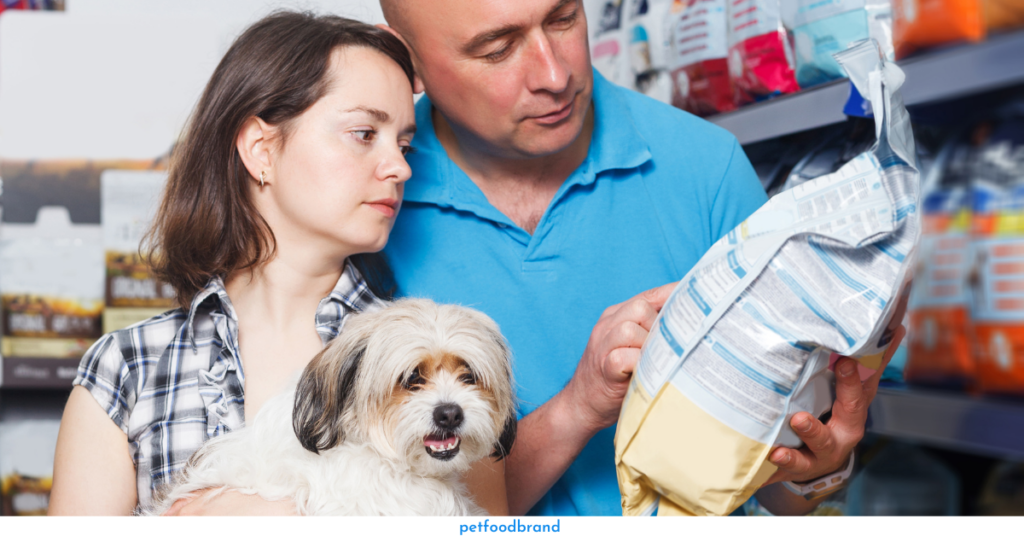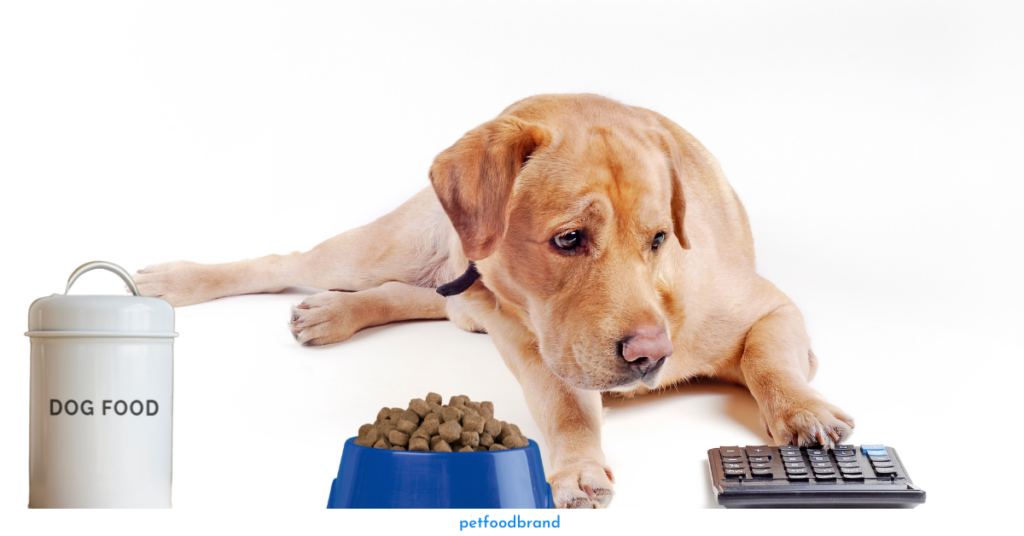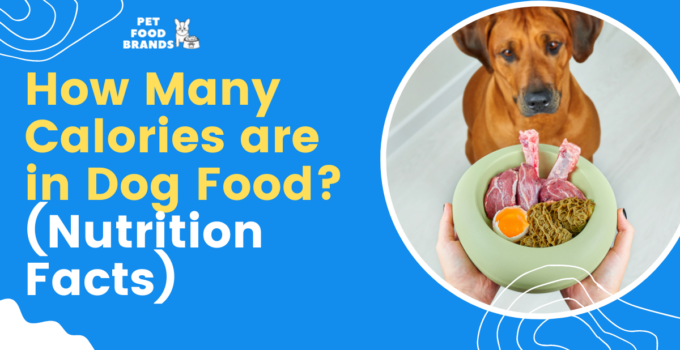You can buy the right dog food and kibbles at the supermarket and give them twice a day to your pet. Still, it might not be enough for your pup. Do you wonder why?
You need to figure out exactly how many calories your dog needs and then decide on the food you’re offering and portion size.
But how to figure out how many calories are there in dog food? While an average dry food for dogs can contain 325-600 calories, you can calculate the exact calories present in dog food on the basis of the ingredients.
Still curious? Keep reading to get some clarity about the calories present in dog food and how much your dog needs each day to stay happy and active.
Calculating Calories in Dog Food in 5 Easy Ways
As a pet parent, it is natural for you to worry about meeting your beloved pup’s needs, including the right amount of calories. If you’re unsure about how many calories are present in dog food, let me help you figure it out in 5 easy steps:
1. Read the Label

The first thing you can do here is carefully look at the dog food label you plan to get. Within all the information provided, you will find a section on “Guaranteed Analysis” listing out the percentages of protein, carbohydrates, fat, fiber, moisture, and ash printed on the packet, tray, or even in a can of dog food.
The overflow of information might seem daunting to you, but to make things easier, let’s take an example. Here’s a nutrition label with this Guaranteed Analysis:
| Nutrient | Percentage |
| Protein | 24% |
| Fat | 14% |
| Fiber | 5% |
| Moisture | 10% |
| Ash | 5.2% |
Besides that, the nutrition label might also indicate the caloric value, like 1 measuring cup of dry food contains 353 calories and 1 kg of the food has 3,557 Calories or kilocalories.
Suppose you have a dog weighing 20 pounds whose daily needs are between 325 – 400 calories; you can give the dog 1 cup of dog food.
But you’ll have to figure out another way if you’re buying canned dog food.
Are you getting canned food for your pup? Then, you may not always find feeding guidelines written on the cups. However, you should refer to the can’s back label to determine the number of calories it contains to figure out how much of the canned food you must give to your dog.
For instance, a 12.7-ounce can of a famous wet dog food brand contains 399 kcal. It also contains a feeding guide by the manufacturer to help you figure out how much of it you should give to your dog.
The feeding guidelines suggest that you can feed your furry friend two cans of it to reach the optimum amount of calories as well as nutrients required.
When searching for the right food with optimum calorie intake, you must remember that each dog brand has a different caloric content.
A brand may contain fewer calories per can or even a cup when compared to a different brand, so you should not follow a thumb rule of feeding a particular amount of cups or cans to your pet. Instead, you must check the feeding guides before offering it to your pet dog.
2. Find Out the Level of Carbohydrates
Once you have the feeding guidelines figured out, let’s move to other contents of the dog food that contribute to the calories. The first one we’ll discuss is carbohydrates.
To calculate the level of carbohydrates in dog food, you don’t need to put all your math knowledge to use. Instead, it’s a very simple formula where you can add the percentage of protein, fiber, fat, moisture, and ash and then just subtract it from 100.
For the example we are discussing, this is how it would look:
Carbohydrate Content = 100 – (24% protein + 5% fiber + 14% fat + 10% moisture + 5.2% ash)
The carbohydrate content is 41.8.
3. Calculate the Calories in Every Gram

If you want to be more detailed, you should track the calories present in every gram. And you can do that by determining the calories present in the various nutrients like protein, fat, and even carbohydrates.
The easy way to calculate it is by dividing the calories given in kcal/kg on the label by 1000 to get kcal/g. This is how it would look:
- 1g protein contains approximately 3.5 Calories (Kcals)
- 1g fat contains around 8.5 Calories (Kcals)
- 1g carbohydrate has 3.5 Calories (Kcals)
4. Determine the Calories of Every Nutrient
Continuing with our example, when you check the label of the dog food, it might give you information about the protein level, which is 24%, the fat content, which is 14%, and even carbohydrates, at 41.8%. However, these levels are only for 100g of pet food, implying that it contains:
- 24g of protein
- 14g of fat
- 41.8g of carbohydrates
If you want to find out the total calories, multiply these figures by the calories in each gram that we calculated above in Step 3.
- Protein: 24g x 3.5 calories = 84 calories
- Fat: 14g x 8.5 calories = 119 calories
- Carbohydrates: 41.8g x 3.5 calories = 146.3 calories
5. Sum it up
Lastly, you need to add all the calories you just calculated of fat, protein, and carbohydrates to find the total amount of calories.
119 + 84 + 146.3 = 349.3
The approximate calories in 100g of this pet food are 349.3 Calories (Kcals).
How Many Calories Does a Dog Need in a Day?
Just like your dog is different from your neighbor’s, their calorie needs might also vary. A canine’s breed, size, age, metabolism, and even the energy expended will help determine the need.
Ideally, a large breed like a German Shepherd will require less food and calories per pound or kg of body weight than a dog of a smaller breed like a Shih Tzu.
1. Small Breed
A dog whose adult body weight is under 20 pounds falls under this category. An adult dog of a small breed will require around 50 kcal for every pound of their body weight daily. You can consider a Chihuahua, Pug, or Shih Tzu and a lot more as a small breed.
2. Medium Breed
It includes dogs weighing 20-50 pounds, and these adult dogs of medium breeds will need 30 to 40 kcals of body weight daily. English Cocker Spaniel, Bulldog, etc., can be considered in this category.
3. Large Breed
Large breed dogs weigh between 50 to 100 pounds, and the giant breeds can exceed even 100 pounds as adults. The daily requirement of these dogs is between 20 to 30 kcals for every pound of their weight. German Shepherd, Irish Setter, Rottweiler – all of these are large breeds.
Calculating The Exact Optimal Calorie Intake of Your Dog
While the average calorie intake I’ve given above works for some pet parents, it might not work for you. Do you want to know the exact daily optimum calorie requirement? Well, let me help you find that out in three steps:
- Convert the dog’s body weight from pounds to kilograms (kg) by multiplying it by 2.2.
- Find out RER or Resting Energy Requirement = 70 x (body weight in kg)^0.75.
- Calculate the MER or Maintenance Energy Requirement = Appropriate Multiplier x RER.
The common multiplier used for MER refers to extra activity that a dog needs to do or might need more energy for. It can include activity level, pregnancy, or breastfeeding, and if it is neutered or not.
Frequently Asked Questions
Is Dog Food High in Calories?
Not all dog foods have high calories, but some brands like Purina, Bully Max, and American Journey offer more calories.
Which Food Can Make Dogs Gain Weight?
A diet rich in protein can help a dog gain weight. You can choose protein-rich ingredients like meat, eggs, and even cottage cheese.
How Much Protein Does 1 Cup of Dog Food Contain?
The amount of protein in a cup can range from 8% – 18%, depending on the brand you choose.
Final Thoughts
Your dog’s health depends majorly on how many calories they are taking in on a daily basis. It can affect everything from their weight, digestion, energy level, and overall well-being.
You can calculate the calories present in dog food on the basis of the guaranteed analysis given on the label or even try to determine it as per the ingredients. It will help you find out how much calories and food your dog needs and help you keep them healthy and fit!

Ankita is a passionate pet lover and head of content at Pet Food Brands. With her extensive knowledge and research, she provides pet owners with top-quality information on dog food and nutrition. Her dedication to improving the lives of dogs makes her a leading voice in the industry.




